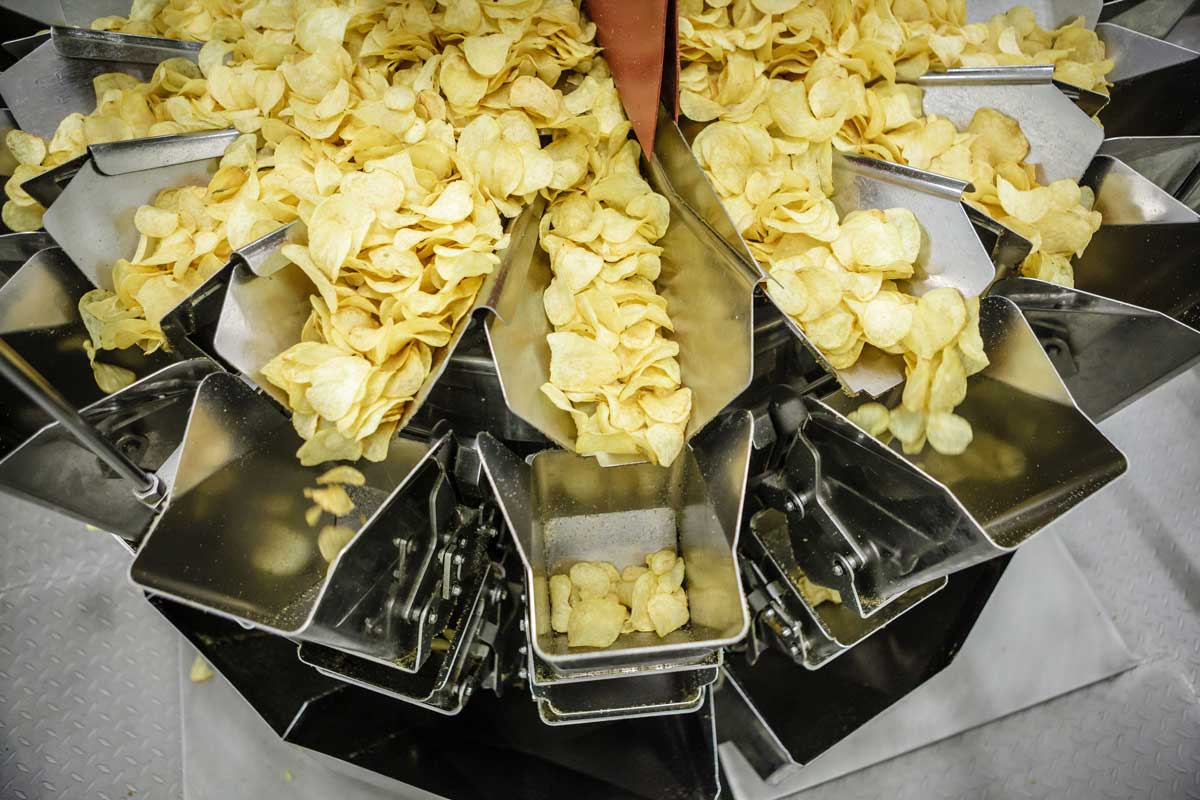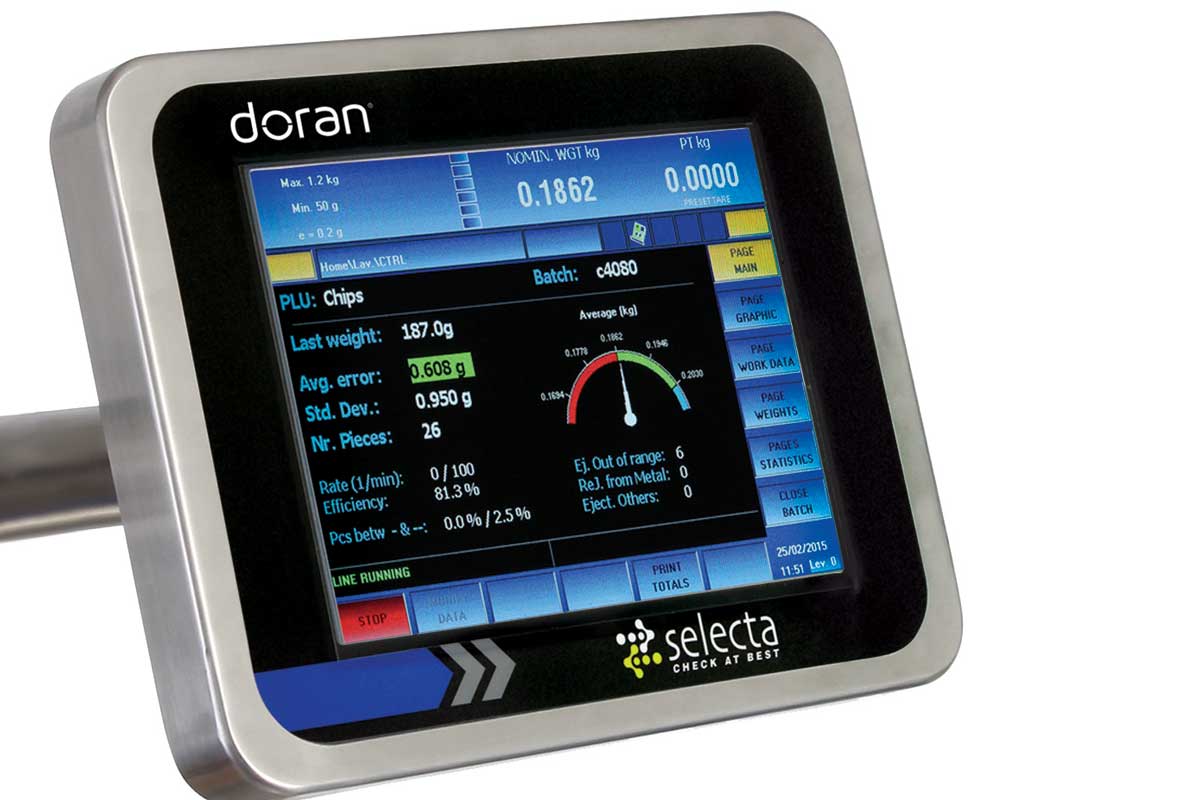Imagine that two consumers purchased the same 10-oz bag of chips. One opens his package, and it’s three-quarters full, while the other person discovers her snack is equivalent to just a handful. Someone will complain and get his or her money back.
What a product’s packaging says about its weight should be its reality. For this reason, accurately scaling and weighing a snack or bakery item before it gets to the store is crucial. Not only does data from these machines match the amount of product with the desired size, keeping companies in compliance, but it also helps them pinpoint areas upstream and downstream where systems can improve, lower cost and reduce waste to provide overall consistency.
Products affect accuracy
While vertical scaling and checkweighing both verify the precision of a product’s weight, because of their variances in movement, there are some differences that must be accounted for to guarantee uniformity.
Vertical scaling weighs products such as crackers, chips and frozen baked goods as they enter vertical form/fill/seal packaging equipment.
“Product characteristics, film thickness, film material, bag air fill, modified atmospheres, back seal type, end seal length, and local regulation on minimum weight or average weight declarations are amongst many other things that will all have to be taken into consideration,” said Paul Webster, product manager of packaging and distribution, TNA. “Ultimately, product testing is always the best indicator of performance.”
To avoid product breakage as it’s moving high to low, TNA incorporates a rotary jaw mechanism, which allows product to land on a moving surface.
“This ‘catching’ action is one of the reasons our customers trust us with their most fragile products, even at fast production speeds,” Mr. Webster explained.

Another way to avoid product damage in vertical scaling systems is to keep an eye on transition areas.
“When we design a system that maintains product integrity, we look at the overall system stack-up and ensure each transition point — infeed to scale, scale to vertical form/fill/seal, discharge — is addressed,” said Brian Barr, sales manager, Heat and Control. “Heat and Control/Ishida offers various enhancements, which minimize any product degradation.”
Horizontal weighing systems, which convey a variety of products and packaging, also must verify consistency and discard inconsistency. The ability to identify product giveaway on checkweighers is key.
“This enables bakeries to control ingredient volumes in a variety of ways like direct-filler feedback or mean-value trend monitoring,” said Steve Tullio, inside sales manager, Mettler Toledo.
Jeff Heath, vice-president of business development, west region, Doran Scales, said companies should decide the rejection requirements for a product based on weight or size. Will there be additional systems such as a metal detector to verify these requirements? How can companies reject inconsistencies without damaging the product or package?
Mr. Heath explained reject systems come in a variety of forms, including a blast of air or a pusher to move product off the out-feed belt. Product can then go into a reject bin or onto a secondary conveyor until the company decides what to do with the inconsistent product and/or packaging.
To minimize the amount of product that’s rejected, Mr. Heath suggested taking a pivotal step.
“We recommend that the operator perform a one-time calibration for each product weighed — taking 20 to 30 samples to determine the variance or average weight,” he noted. “That information is used to set the desired tolerance plus-minus of that target weight.”
Packaging affects speed
A bottle isn’t a bag. A bag isn’t a box. A box isn’t a bottle. While this is obvious, it might be less known that these packaging formats can’t be weighed the same way. Boxes and bottles, for example, weigh more than bags. When larger bags are conveyed across the checkweigher, Mr. Heath explained that they can be affected by air drafts, moving the package like a sail. Smaller bags have a similar issue, except that high speeds actually can lift them off the conveyor. This can alter the weight sensed by the scaling machines.
“As bagged items become more popular, in-motion weighing has responded with designs that can compensate for these and other issues,” Mr. Heath said. “For example, the Selecta in-motion checkweigher saves this information and keeps the selected target weight along with the desired tolerance plus-minus of that target weight. Because the system can weigh at a half-gram tolerance, the product weight can be very precise — even at high speeds.”
Due to packaging variations, flexibility with scaling and weighing technology is paramount.
The first question businesses should answer before selecting a system is: Can it handle the weight validation of the product and packaging format?
“Heat and Control, along with our partners at Ishida and CEIA, use principles of speed, accuracy, efficiency, performance and flexibility with our newest systems,” Mr. Barr said. “Because a dedicated line is a luxury in today’s manufacturing environment, we designed flexibility, both mechanical and electrical, into our systems to give bakers and snack makers the ability to meet their customers’ changing demands.”
The company’s vertical scaling systems can inspect the density and pressure of bulk or small package items of frozen or fresh baked foods.
Doran Scales considers flexibility to be one of the top criteria for checkweighers.
“That’s why our Selecta system comes in different belt sizes: 500 mm by 300 mm, 400 mm by 250 mm, 300 mm by 200mm,” Mr. Heath explained. “This allows for weighing the smallest package to the largest package on a particular line at the fastest speeds, or parts per minute.”
Versatility might also mean combining packaging technology and scaling and weighing systems.
“What is commonly ignored is the integration between these two technologies to provide one ‘solution,’” Mr. Webster noted. “After all, the speed at which the bagger can operate is also influenced by the speed of the other components that make up the line.”
TNAs packaging solutions are fully integrated systems with high-speed multi-head weighers. Integrated metal detectors can be positioned much closer to the weigher to increase speed, and automation technology offers a single point of control.
Systems affect bottom line
As baking and snack companies seek to verify that each product on retail shelves is identical, the big obstacle that could stand in their way is simply unreliable equipment. So, the priority should be research, research and more research.
The first question businesses should answer before selecting a system is: Can it handle the weight validation of the product and packaging format?
“In general, the technology has made leaps in achieving greater capacity, flexibility and accuracy, and the advancements are due to excellent engineering, quality manufacturing and total system design,” Mr. Heath noted.
Machines are becoming more flexible as efficiency ramps up and lowering cost continues to be an overarching goal for baking and snack companies.
“Today’s checkweighers offer a variety of material handling options to assist with product transfers, provide proper spacing for weighing needs as well as a variety of reject options for the various package sizes and packaging formats produced on today’s bakery lines,” said Mr. Tullio who described Mettler Toledo’s C-Series checkweighers as “future proof.” For example, they are designed to adapt to various conveyor sizes, which are modified with product cycle.

The software incorporated with vertical scales and checkweighers also must adapt to the product variety and its packaging.
“Standard statistical information provides real-time and historical information on your production run for data management,” stated Bill Nutting, product manager, checkweighing systems, Heat and Control. “Also, optional feedback control can provide an upstream signal to help control fill weights, reducing product waste.”
The second important factor is to determine if the system can be integrated into the overall production line without creating bottleneck.
“You want the system to drive efficiency and productivity and not be a weak link in the production process,” Mr. Heath said. “Producers should consider how checkweighers function within the production system and how they can improve overall operations and lower costs.”
Mr. Nutting said Ishida checkweighers feature enhanced sensitivity for greater efficiency.
“The load cell’s new rigid design allows weight to stabilize quickly and ensures fast speeds and accurate weighing,” he said. “We make operation controls intuitive and minimize maintenance requirements based on robust design and fail-safe and autocorrect features.”
Easy sanitation is a major part of maintaining efficiency, too. The Selecta from Doran Scales is complemented by food-grade belts that are easy to unclip and remove for cleaning and inspection. Additionally, the conveying sections open up for cleaning.
“The unit itself has minimalist design with no horizontal surfaces to accommodate sanitation concerns,” Mr. Heath explained. “The goal should be to reduce downtime during changeovers and avoid shutting down the system for maintenance and repairs.”
Lastly, baking and snack companies are encouraged to research and determine what will give the best R.O.I. by looking at the initial investment as well as the total cost of ownership.
Not only can this be a brand decision, but it can also be a choice between vertical scaling and checkweighing.
“A multi-head weigher can offer customers the benefits of full automation,” Mr. Webster said. “By reducing labor requirements and the associated costs, a TNA packaging system can offer 24/7 production. A checkweigher offers an additional level of weight control. For example, in our integrated powder pack solutions, we are able to take feedback from the checkweigher to ensure the powder delivery from the auger is always calibrated accurately.”
And accuracy is what baking and snack companies strive to give consumers. Whether using vertical scaling or checkweighing technology, a product line can be consistent so that what a consumer is seeing on a package is really what they’re getting inside.




